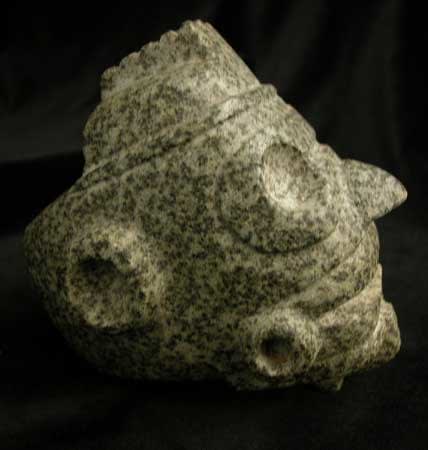Atlantic Watershed Spotted Greenstone Mace Head, 1 CE - 500 CE
Greenstone
3 x 4.75 x 4.5
PF.6243
Further images
Known throughout the ancient Americas by many names, Tlaloc, the great god of water, was probably one of the oldest gods worshiped in the Pre-Columbian pantheon as a result of...
Known throughout the ancient Americas by many names, Tlaloc, the great god of water, was probably one of the oldest gods worshiped in the Pre-Columbian pantheon as a result of the importance of rain for agriculture. Tlaloc was not a creator god, but one created by other deities. Although a beneficent god, Tlaloc certainly had the power to unleash floods, lightning and drought when angry. To appease this powerful god, children were sacrificed to him as well as prisoners dressed in his image. Legend has it that the more babies and children cried, the more Tlaloc was pleased. During the sacrifices, the tears of the screaming children were seen as representations of falling rain; the more the children cried, the better the rain season. Tlaloc can easily be identified by his characteristic mask, giving him the impression of eyeglasses.
This ancient carved mace head, whose form derives from a weapon of war, was probably carried in a ceremonial capacity by a clan or group. With abstract power, it depicts the head of a man dressed in the guise of the mighty deity, Tlaloc. Perhaps this figure is waiting to be sacrificed. Perhaps this mace head commemorates a specific prisoner whose sacrifice brought on a particularly rainy season. Might this mace have once been used in the sacrificial rites conducted in the honor of this god? Might this mace actually represent the god himself? Surely the spectacle-like form that outlines his eyes reveals that this mace head has a direct relation to Tlaloc. Even after the passage of centuries, it radiates an awesome power that captures our attention and holds us riveted.
This ancient carved mace head, whose form derives from a weapon of war, was probably carried in a ceremonial capacity by a clan or group. With abstract power, it depicts the head of a man dressed in the guise of the mighty deity, Tlaloc. Perhaps this figure is waiting to be sacrificed. Perhaps this mace head commemorates a specific prisoner whose sacrifice brought on a particularly rainy season. Might this mace have once been used in the sacrificial rites conducted in the honor of this god? Might this mace actually represent the god himself? Surely the spectacle-like form that outlines his eyes reveals that this mace head has a direct relation to Tlaloc. Even after the passage of centuries, it radiates an awesome power that captures our attention and holds us riveted.











